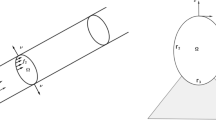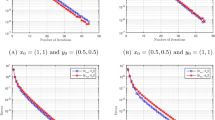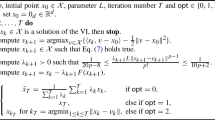Abstract
In this paper, the weak sharpness property of solution sets of a split variational inequality problem is studied. Further, finite convergence analysis of the iterative methods for solving the split variational inequality problem and its special case, split feasibility problem are investigated. We also provide an application of split variational inequality problem in traffic network analysis and numerically illustrate our derived results.

Similar content being viewed by others
References
Al-Homidan, S., Ansari, Q. H., & Nguyen, L. V. (2016). Finite convergence analysis and weak sharp solutions for variational inequalities. Optimzation Letters. https://doi.org/10.1007/s11590-016-1076-7.
Barbagallo, A. (2006). Degenerate time-dependent variational inequalities with applications to traffic equilibrium problems. Computational Methods in Applied Mathematics, 6, 117–133.
Burke, J. V., & Ferris, M. C. (1993). Weak sharp minima in mathematical programming. SIAM Journal on Control and Optimization, 31, 1340–1359.
Byrne, C. (2002). Iterative oblique projection onto convex sets and the split feasibility problem. Inverse Problems, 18, 441–453.
Byrne, C. (2004). A unified treatment of some iterative algorithms in signal processing and image reconstruction. Inverse Problems, 20, 103–120.
Byrne, C. (2001). Bregman-Legendre multidistance projection algorithms for convex feasibility and optimization. In D. Butnariu, Y. Censor, & S. Reich (Eds.), Inherently parallel algorithms in feasibility and optimization and their applications (pp. 87–100). Amsterdam: Elsevier.
Censor, Y., Bortfeld, T., Martin, B., & Trofimov, A. (2006). A unified approach for inversion problems in intensity-modulated radiation therapy. Physics in Medicine & Biology, 51, 2353–2365.
Censor, Y., & Elfving, T. (1994). A multiprojection algorithm using Bregman projections in product space. Numerical Algorithms, 8, 221–239.
Censor, Y., Elfving, T., Kopf, N., & Bortfeld, T. (2005). The multiple-sets split feasibility problem and its applications for inverse problems. Inverse Problems, 21, 2071–2084.
Censor, Y., Gibali, A., & Reich, S. (2012). Algorithms for the split variational inequality problem. Numerical Algorithms, 59, 301–323.
Censor, Y., & Segal, A. (2009). The split common fixed point problem for directed operators. Journal of Convex Analysis, 16, 587–600.
Chen, M., & Huang, C. (2018). A power penalty method for a class of linearly constrained variational inequality. Journal of Industrial and Management Optimization, 14, 1381–1396.
Dafermos, S. (1980). Traffic equilibrium and variational inequalities. Transportation Science, 14, 42–54.
Daniele, P., Maugeri, A., & Oettli, W. (1999). Time-dependent traffic equilibria. Journal of Optimization Theory and Applications, 103, 543–555.
Fichera, G. (1964). Problemi elastostatici con vincoli unilaterali: il problema di Signorini con ambique condizioni al contorno. Atti Accad. Naz. Lincei, Memoria presentata il, 7, 91–140.
Fichera, G. (1963). Sul problema elastostatico di Signorini con ambigue condizioni al contorno. Rendiconti della Accademia Nazionale dei Lincei, Classe di Scienze Fisiche, Matematiche e Naturali, 34, 138–142.
Fulina, S. (2006). On pseudomonotone variational inequalities. Analele Stiintifice ale Universitatii Ovidius Constanta, 14, 83–90.
Gibali, A. (2017). A new split inverse problem and application to least intensity feasible solutions. Pure and Applied Functional Analysis, 2, 243–258.
Gibali, A., Ha, N. H., Thuong, N. T., Trang, T. H., & Vinh, N. T. (2019). Polyak’s gradient method for solving the split convex feasibility problem and its applications. Journal of Applied and Numerical Optimization, 1, 145–156.
Gibali, A., Mai, D. T., & Vinh, N. T. (2019). A new relaxed CQ algorithm for solving split feasibility problems in Hilbert spaces and its applications. Journal of Industrial and Management Optimization, 15, 1–22.
Hiriart-Urruty, J.-B., & Lemaréchal, C. (2001). Fundamentals of convex analysis. Berlin: Springer.
Hu, Y. H., & Song, W. (2011). Weak sharp solutions for variational inequalities in Banach spaces. Journal of Mathematical Analysis and Applications, 374, 118–132.
Jayswal, A., & Singh, S. (2018). Characterization of weakly sharp solutions of a variational-type inequality with convex functional. Annals of Operations Research, 269, 297–315.
Latif, A., & Qin, X. (2017). A regularization algorithm for a splitting feasibility problem in Hilbert spaces. Journal of Nonlinear Sciences and Applications, 10, 3856–3862.
Lawphongpanich, S., & Hearn, D. (1984). Simplical decomposition of the asymmetric traffic assignment problem. Transportation Research Part B: Methodological, 18, 123–133.
Li, J., Huang, N. J., & Yang, X. Q. (2010). Weak sharp minima for set-valued vector variational inequalities with an application. European Journal of Operational Research, 205, 262–272.
Marcotte, P., & Zhu, D. (1998). Weak sharp solutions of variational inequalities. SIAM Journal on Optimization, 9, 179–189.
Mangasarian, O. L., & Mayer, R. R. (1979). Nonlinear perturbation of linear programs. SIAM Journal on Control and Optimization, 17, 745–752.
Matsushita, S.-Y., & Xu, L. (2013). Finite convergence of the proximal point algorithm for variational inequality problems. Set-Valued and Variational Analysis, 21, 297–309.
Matsushita, S.-Y., & Xu, L. (2013). On finite convergence of iterative methods for variational inequalities in Hilbert spaces. Journal of Optimization Theory and Applications. https://doi.org/10.1007/s10957-013-0460-z.
Moudafi, A. (2011). Split monotone variational inclusions. Journal of Optimization Theory and Applications, 150, 275–283.
Panicucci, B., Pappalardo, M., & Passacantando, M. (2007). A path-based double projection method for solving the asymmetric traffic network equilibrium problem. Optimization Letters, 1, 171–185.
Patriksson, M. (1993). A unified framework of descent algorithms for nonlinear programs and variational inequalities. Linköping Institute of Technology: Department of Mathematics. (PhD. Thesis).
Qin, X., & Wang, L. (2017). A fixed point method for solving a split feasibility problem in Hilbert spaces. RACSAM. https://doi.org/10.1007/s13398-017-0476-6.
Raciti, F. (2008). Equilibrium conditions and vector variational inequalities: A complex relation. Journal of Global Optimization, 40, 353–360.
Shehu, Y., & Iyiola, O. (2019). On a modified extragradient method for variational inequality problem with application to industrial electricity production. Journal of Industrial and Management Optimization, 15, 319–342.
Singh, S., Pitea, A., & Qin, X. (2019). An iterative method and weak sharp solutions for multitime-type variational inequalities. Applicable Analysis. https://doi.org/10.1080/00036811.2019.1679787.
Smith, M. J. (1979). The existence, uniqueness and stability of traffic equilibrium. Transportation Research, 13, 295–304.
Stampacchia, G. (1964). Formes bilinaires coercitives sur les ensembles convexes. C R Acad Sciences de Paris, 9, 4413–4416.
Treanţă, S., & Singh, S. (2020). Weak sharp solutions associated with a multidimensional variational-type inequality. Positivity. https://doi.org/10.1007/s11117-020-00765-7.
Wu, Z. (2018). Characterizations of weakly sharp solutions for a variational inequality with a pseudomonotone mapping. European Journal of Operational Research, 265, 448–453.
Acknowledgements
The authors are heartily grateful to the reviewers for their valuable remarks which greatly improved the results and presentation of the paper.
Author information
Authors and Affiliations
Corresponding author
Additional information
Publisher's Note
Springer Nature remains neutral with regard to jurisdictional claims in published maps and institutional affiliations.
Rights and permissions
About this article
Cite this article
Singh, S., Treanţă, S. Characterization results of weak sharp solutions for split variational inequalities with application to traffic analysis. Ann Oper Res 302, 265–287 (2021). https://doi.org/10.1007/s10479-021-03971-y
Accepted:
Published:
Issue Date:
DOI: https://doi.org/10.1007/s10479-021-03971-y
Keywords
- Split variational inequality problem
- Split feasibility problem
- Weak sharp solution
- Finite termination property
- Traffic network equilibrium problem
- Wardrop condition




